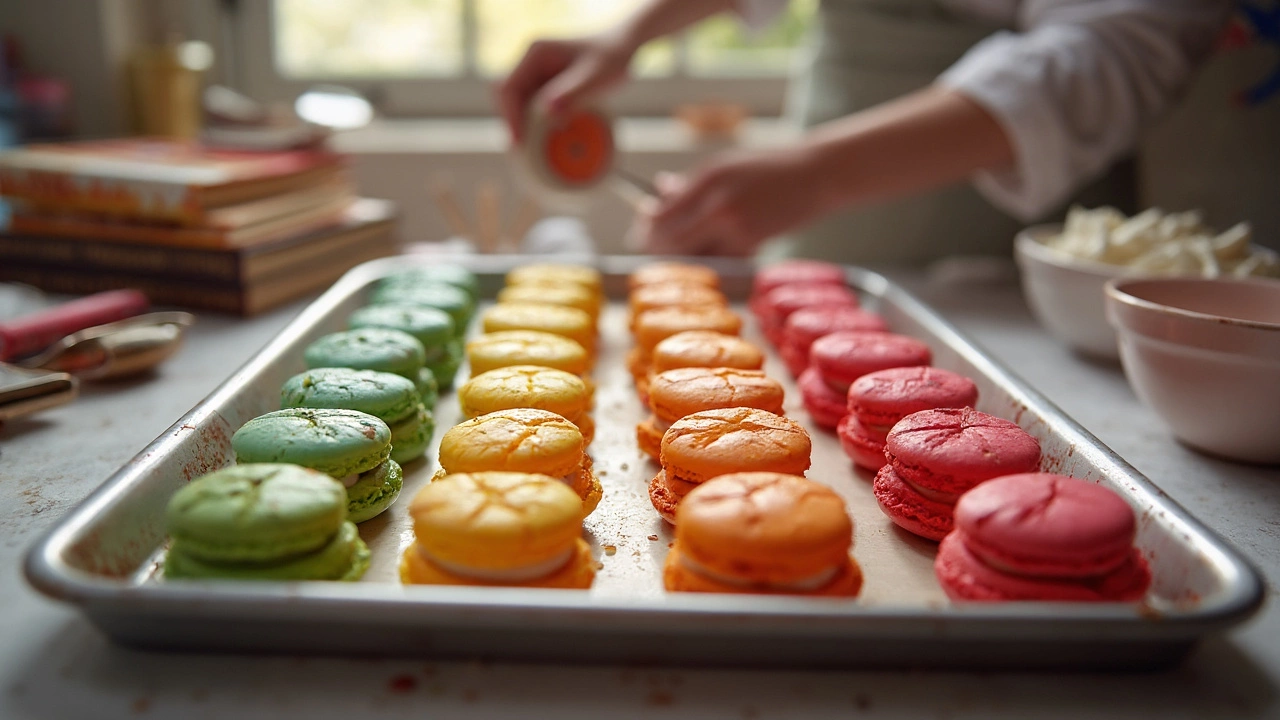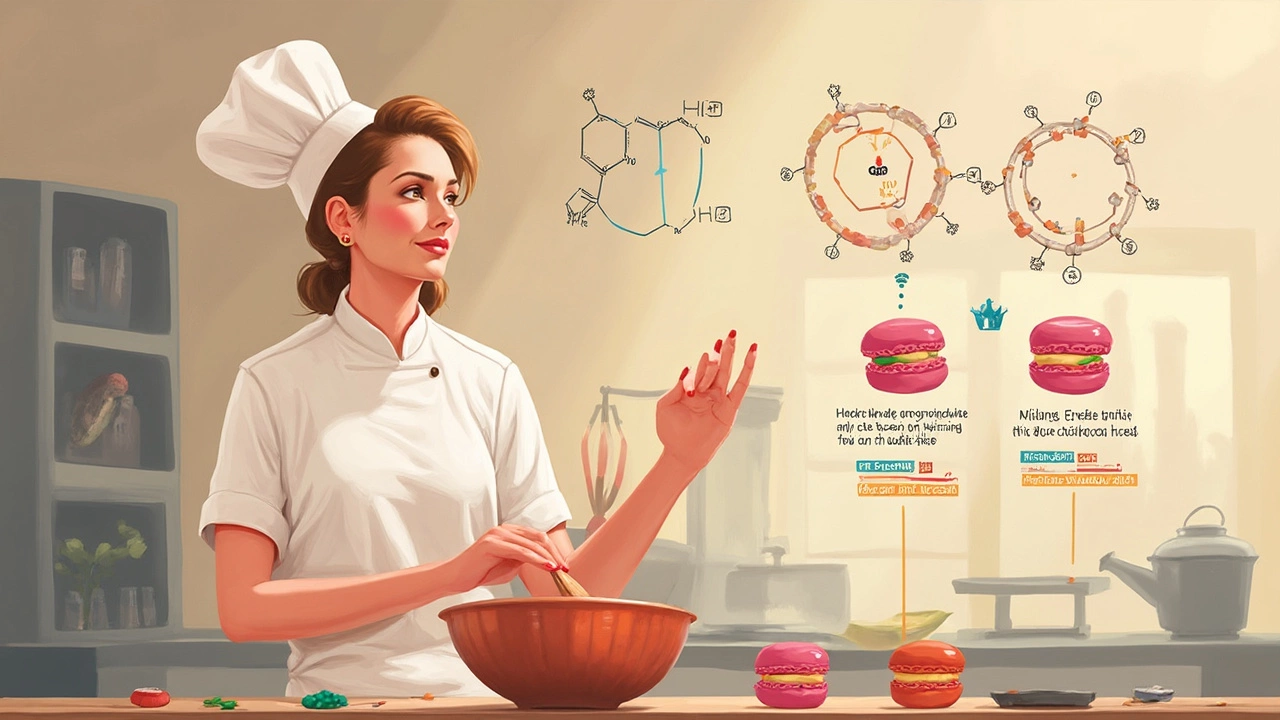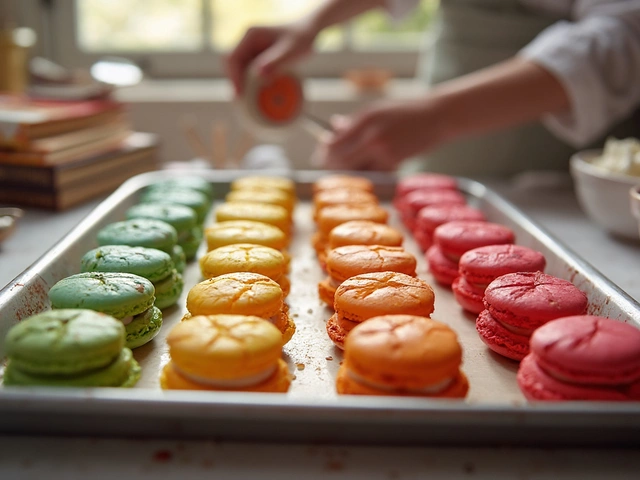
Cracking shells can make you want to give up on macarons before you ever master them. Honestly, nothing stings more than opening the oven and seeing your beautiful shells all split and ruined. But don't toss your spatula just yet—there are some very clear reasons why this happens, and you can totally fix them.
The main villains? Trust me, it's usually a mix of too much air in the batter, an unstable meringue, or the oven being a little too hot or unpredictable. Sometimes it's something as simple as skipping the step where you let the piped batter sit before baking. Other times, the almond flour was too coarse or had clumps.
These aren't mysteries, just small steps that can trip anyone up. Once you know what trips most bakers, you'll have a better shot at making those perfectly smooth, footed shells every time you bake. Ready to figure out which fixes actually work in a real kitchen?
- What Causes Macarons to Crack?
- Mixing and Macaronage: When Technique Fails You
- The Oven Factor: Heat, Humidity, and Rack Placement
- Ingredient Mistakes and How to Avoid Them
- Actionable Fixes: Hands-on Tips for Smooth Shells
What Causes Macarons to Crack?
It feels a bit dramatic, but there’s a pretty short list of things that usually make macaron cracks show up in the oven. If your shells are cracking, it’s almost always a problem with air, temperature, or an ingredient mistake. Learning what causes macarons to crack is half the battle toward nice, smooth shells.
The main culprits behind why macarons crack include:
- Oven temperature is too high. When the heat is cranked up or spikes, the shells set hard on top before the interior has finished rising. That trapped steam busts right through, popping the shells open.
- Batter is over- or undermixed. Overmixing knocks out air, so the feet won’t form and the top collapses. Undermixing leaves air bubbles that expand and blow up the shells as they bake.
- No resting before baking. If you slide macarons into the oven before the skin forms, the shells don’t have a protective layer. Steam escapes wherever it wants, usually right through the middle.
- Meringue issues. If your meringue is under-whipped, the structure is weak. If it’s over-whipped, it dries out and breaks down when you fold in almond flour. Either way, it can mess up the rise and cause cracking.
- Too much humidity. Humid kitchens or rainy days mess with drying time and shell structure. Too much moisture means the shells never form that crucial skin before you bake.
To make it even simpler, here’s how these factors stack up when bakers run into macaron troubleshooting:
| Cause | How It Leads to Cracking |
|---|---|
| Oven Too Hot | Shell crusts form fast, steam escapes forcefully |
| Under/Overmixed Batter | Air pockets or weak structure |
| No Resting | No protective skin, uneven rise |
| Meringue Problems | Weak or dry structure collapses |
| Humidity | Shells don’t dry; crack while baking |
So if your macaron shells look like they’ve exploded, there’s usually a straightforward reason hiding in the process. Fixes start with figuring out where things went off track—often, it’s right in one of the steps above.
Mixing and Macaronage: When Technique Fails You
If you get the mixing part wrong, your macaron shells will crack, lose their shape, or never form those gorgeous feet. Mixing the batter—what bakers call "macaronage"—is all about balance. Too much mixing? Your batter runs everywhere and the shells collapse or bake into weird blobs. Not enough mixing? The shells bake up lumpy or with cracks because air pockets get trapped inside.
What's actually happening here? When you add the almond flour and powdered sugar blend to your meringue, you need to fold everything until it flows like lava. The right batter will slowly run off your spatula in thick ribbons, not in big clumps and not watery either. This is where most beginners mess up.
If you see a lot of cracks, take a step back and check your macaronage. A batter that's undermixed traps big bubbles. Those bubbles expand quickly in the oven, pushing through the top and causing cracks. Overmixing, though, knocks all the air out and leads the shells to spread too thinly—those often get hollow, wrinkly, or flat instead of cracked, but it's all related.
- Use a wide spatula and fold gently instead of stirring in circles.
- Scrape the sides down to make sure the dry ingredients get evenly moistened.
- Test if your batter makes a figure 8 without breaking—it should come off the spatula in a smooth ribbon.
One tip that helped me: Count your folds. After you add the dry mix, start checking at about 35 folds. By 45-50 folds, most batters are in the sweet spot. Too many? Start over—the batter can't be fixed.
Here’s a quick cheat sheet backed by lots of kitchen tests with why macarons crack because of bad mixing:
| Problem | What It Means | Result in Shell |
|---|---|---|
| Undermixed | Too many air bubbles, thick batter | Cracks, hollow shells |
| Overmixed | Batter flows too easily, too thin | Flat, spread-out shells, no feet |
| Well-mixed | Batter makes a slow, steady ribbon | Smooth, crack-free, with feet |
Nail your macaronage, and you'll dodge one of the top causes for macaron cracks faster than you think. If your first batch goes wrong, don’t stress—most of us over- or undermix the first few times. Nothing replaces a little practice and paying close attention to the batter's look and feel.

The Oven Factor: Heat, Humidity, and Rack Placement
Here’s where a lot of macaron cracks start—right in your oven. Even if you’ve mixed the batter exactly right, your shells can still split if your oven’s acting up. Let’s break down what actually happens inside.
Oven temperature is the biggest cause of cracked shells. If it’s too hot, the shells rise fast and burst open. Too cool, and they never set their skin, so cracks happen anyway. Most bakers find success somewhere between 280°F and 320°F (140°C–160°C). But don’t trust what the oven screen says—oven temps can be way off. Stick an oven thermometer in there to double-check. You’d be surprised how off some ovens can be, even new ones!
Humidity is another sneaky culprit. On super humid days, the shells won’t dry out right after piping. Without a good dry skin, they’re weak and more likely to crack in the oven. If you’re baking on a rainy day, try running a dehumidifier in the kitchen, or give the shells extra time before baking. Some days, mine have needed nearly an hour to dry out.
Where you put your tray also matters. For macaron baking tips, use the middle rack so they bake evenly. Too close to the top and the heat can make them pop open. On the bottom, they could burn before even forming feet. Been there, burned that—trust me, stick to the middle.
"Consistent oven heat is absolutely crucial—just a 10-degree jump can ruin perfect macaron shells." – Chef Stella Parks, pastry expert
If you're curious about how oven temp can fluctuate (and it often does), check this out:
| Oven Setting | Actual Temp (measured) |
|---|---|
| 300°F (150°C) | 287–315°F (142–157°C) |
| 325°F (163°C) | 310–335°F (154–168°C) |
That’s why it pays to test your actual oven settings. One last thing—a lot of bakers swear by baking macarons with the oven door slightly propped open, especially in older ovens. This lets out excess moisture and heat, stopping the shells from puffing up too fast.
- Always preheat your oven for at least 15 minutes before macarons go in.
- Double-check with an oven thermometer, especially if you’re struggling with macaron troubleshooting.
- Don’t rush drying time—shells should be fully dry to the touch so the oven’s heat doesn’t crack them.
- Keep trays in the center, and don’t overload the oven with too many sheets at once.
If you fuss over getting these basic steps right, you’ll crush one of the biggest reasons why macaron shells crack. Oven control is everything for that perfect batch.
Ingredient Mistakes and How to Avoid Them
If you want smooth shells and no cracks, you can’t just grab any bag of almond flour or sugar off the shelf. The type, quality, and even how you measure your ingredients can make or break your macaron shells. Let’s see where most people slip up.
Almond flour is key. If it’s not super fine, you’ll get lumpy batter, which means your macaron shells might burst. Sift it together with powdered sugar—not once, but two or three times. Some bakers even pulse them together in a food processor for extra smoothness.
Egg whites: Never use fresh eggs straight from the fridge. Older, room-temperature egg whites whip up way better and help keep your meringue stable, which stops those annoying cracks.
Then there’s sugar. For French meringue macarons, granulated sugar is best; for Italian, use caster sugar. Use a digital scale—don’t eyeball it. Too much sugar makes sticky shells; too little, and your macarons crack or collapse.
- Oily almond flour is a hidden danger—if your flour is too oily or clumps easily, dry it out on a baking tray at a low temp for 5-10 minutes and let it cool before using.
- Don’t use baking powder or baking soda—these create bubbles that break your perfect macaron shells.
- If you’re adding color, use gel or powder, not liquid. Liquids mess with your batter’s texture, leading to cracks or holes.
Check this quick ingredient guide for smoother macarons:
| Ingredient | Right Way | What Goes Wrong |
|---|---|---|
| Almond Flour | Super fine, sifted twice | Cracks, bumps, oily shells |
| Egg Whites | Room temperature, aged 1-2 days | Unstable meringue, cracks |
| Powdered Sugar | Sifted, no clumps | Lumpy shells, rough texture |
| Food Color | Gel or powder | Runny batter, cracked shells |
Stick with this ingredient strategy and you’ll notice way fewer cracks—and way more Instagram-worthy batches—coming out of your oven.

Actionable Fixes: Hands-on Tips for Smooth Shells
Let’s turn frustration into perfect macaron shells that don’t crack a bit. It’s easier when you follow a solid checklist, trust me. Here’s what really works to solve the most common crack triggers for macaron cracks and get those Instagram-worthy results.
- Sift everything, twice if you have to. Almond flour and powdered sugar clumps leave little air pockets that pop in the oven. Run them through a fine sieve before mixing, no shortcuts here.
- Weigh ingredients, don’t eyeball. Using a kitchen scale is honestly non-negotiable. A few extra grams of almond flour or egg white makes all the difference in stability and texture.
- Stop overmixing (or undermixing). During the macaronage, mix until it looks like slow-moving lava. If it falls from the spatula in ribbons and you can draw a figure 8, you’re on the right track. Too runny or too thick? Expect macaron cracks and messy feet.
- Let the shells rest. After piping, wait 30–60 minutes until the tops are dry and not sticky. This step forms a skin, so when oven heat hits, they rise instead of burst. If your kitchen’s humid, give it more time or use a fan to speed it up.
- Get oven temp right. Every oven lies a little. Use an oven thermometer and set it between 285°F and 300°F (140°C–150°C). As a test, you can even bake a few shells solo first to see how your oven behaves. If you see cracks, lower by 5–10 degrees next batch.
Here’s a quick comparison of what works and what doesn’t when it comes to cracking issues:
| Action | Result | Risk of Shell Cracking |
|---|---|---|
| Sift dry ingredients | Smooth, lump-free batter | Low |
| Skip resting shells | Tops burst open | High |
| Temperature too high | Rapid rising, cracks | High |
| Proper macaronage | Glossy, even shells | Low |
Don’t forget, even pros have off days with macaron shells. Bake a small batch first, tweak one thing at a time, and jot down your settings and the weather. Next time you spot macaron cracks, you’ll know exactly what caused them, and how to avoid them for good.





